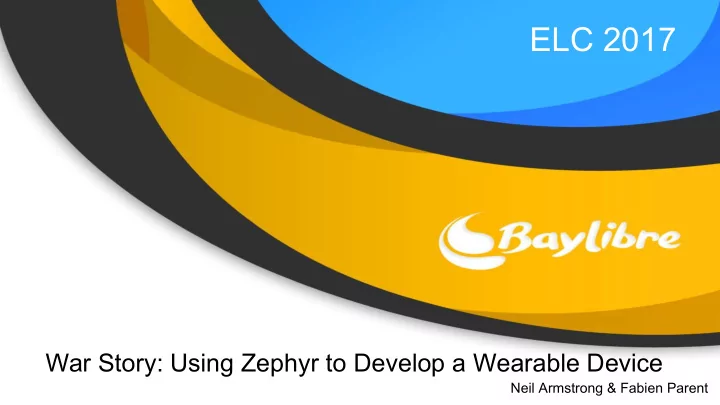

ELC 2017 War Story: Using Zephyr to Develop a Wearable Device Neil Armstrong & Fabien Parent
Agenda ● Based on a true story ● Many choices, why Zephyr? ● Zephyr in a nutshell ● Porting & upstreaming a new platform ● Community differences compared to Linux ● Conclusion
Platform
OS requirements Drivers ● UART ● I2C master driver ● SPI slave driver Basic OS features ● Scheduler ● Timers ● Task/Threads ● Locks ● ...
Choosing the RTOS Our constraints: ● Permissive License ● Free (as in free beer) List of candidates ● NuttX ○ 3-clause BSD license ● Zephyr ○ Apache License 2.0 ● Bespoke OS
Option 1: Bespoke OS Pros ● Fun to implement ● Can be tailored to our needs ● Easy to understand the whole code base Cons ● Takes time ● No community, fewer eyes on code ● Little time to mature and fix early bugs
Option 2: NuttX Pros ● Familiar, used it on previous project (Google’s Project ARA) ● Already supports our SoC (STM32L4xx) Cons ● Build system is completely unreliable ● Optional GPL components are scary ● No meaningful community ● BFDL contributions and maintenance are questionable
Option 2: NuttX No peer review?
Option 3: Zephyr Pros ● Similar in many ways to Linux (coding style, Kbuild, Kconfig, …) ● Strong community is a goal ● Embraces maintainers concept ● Great documentation Cons ● No support for STM32L4xx ● Project still very young, unsure of its maturity ● Not aware of any real product using it
Verdict Obvious winner:
Option X: Apache myNewt Came to our attention after OS selection was completed
Zephyr in a nutshell
Zephyr Features ● Lib C (newlib) ● Designed for low memory usage (everything is statically allocated) ● Highly configurable and modular ● Cooperative and preemptive threading ● Pre-certification for security (someday)
Development Lifecycle Zephyr 1.6 Linux 4.8 Release cycle: ~3/4 months Release cycle: ~2/3 months Merge Window: ~11 weeks Merge Window: ~2 weeks Stabilization: ~3 weeks Stabilization: ~8 weeks
Leadership ● Linux Foundation Technical Steering Committee (TSC) ○ https://lists.zephyrproject.org/pipermail/zephyr-tsc ● Maintainers do not have to be Zephyr Project/TSC members ● Sub-maintainer concept same as Linux ● Planning and technical decisions spread across JIRA, Gerrit & mailing lists ● Blog posts controlled through separate committee
Top-down development ● Features planned in advance ○ Unified Kernel (ZEP-334) ○ New IP Stack (ZEP-322) ○ Thread Protocol (ZEP-337) ● Delayed features may delay closing the merge window ● Do planned features have priority vs community contributions? Source: https://lists.zephyrproject.org/pipermail/zephyr-tsc/attachments/20160817/90b0 0994/attachment-0001.pdf
Adding STM32L4xx support to Zephyr
s/STM32F1/STM32L4/g Solution: copy/paste the closest SoC/board and use them as example. cp -r arch/arm/soc/st_stm32/stm32{f1,l4} cp drivers/clock_control/{stm32f107xx_clock.c,stm32l4xx_clock.c} cp drivers/pinmux/stm32/pinmux_board_nucleo_{f103rb,l476rg}.c cp drivers/serial/uart_{stm32,stm32lx}.c cp -r boards/nucleo_{f103rb,l476rg}
Porting is fast & easy ● Tested platform support added in less than a week ○ STM32L4xx CPU ○ UART ○ I2C ○ SPI ● Most of that time was spent on I2C/SPI testing
Upstreaming the STM32L4 port 1. RTFM https://wiki.zephyrproject.org/view/Collaboration_Guidelines 2. Clean-up patches to follow coding standard and run “checkpatch” 3. Upload patches to gerrit 4. Wait for reviews
Upstreaming the STM32L4 port 1. RTFM https://wiki.zephyrproject.org/view/Collaboration_Guidelines 2. Clean-up patches to follow coding standard and run “checkpatch” 3. Upload patches to gerrit 4. Wait for reviews 5. Ping maintainers on IRC
Upstream ASAP! ● Zephyr is young and its APIs are changing fast ● Rebases are painful ● Power management implementation needed to be rewritten 3 times ● Conclusion: merge code quickly before the base shifts beneath you
Community differences compared to Linux
Zephyr and HALs “ Our goal is [...] porting based on STM32 Cube SDK [...] Would it be ok for you to hold on your upstream, waiting for us to come up with our implementation proposal [...] ” - Gerrit review comment Source: https://gerrit.zephyrproject.org/r/#/c/5194/
Linux and HALs “ No HALs. We don't do HALs in the kernel. ” - Dave Airlie, Linux DRM Maintainer Source: https://lists.freedesktop.org/archives/dri-devel/2016-December/126516.html
To HAL or not to HAL? Input requested from maintainers None is given Result: vendor HALs are slowly replacing native drivers Source: https://lists.linuxfoundation.org/pipermail/zephyr-devel/2016-November/006633.html
Maintainers “ The reason the toplevel maintainer (me) doesn't work for Intel or AMD or any vendors, is that I can say NO when your maintainers can't or won't say it. ” - Dave Airlie, again.
Review tools Gerrit JIRA Mailing list Great talk from Greg K.H. about the tools used for Linux: https://youtu.be/L8OOzaqS37s
JIRA Pros ● Manager-friendly Cons ● Developer-unfriendly ● Yet another communication medium in addition to mailing-lists and gerrit ● Do community contributors need to use it?
Gerrit Pros ● Easy to not forget patches Cons ● Slow ● Unnecessarily complicated ● Patch submitter selects reviewers; no broadcast ● No patch series ● Archive search is bad
Mailing lists Pros ● They work Cons ● None
Conclusion Zephyr Pros ● Similar enough to Linux ● APIs are simple and well documented ● Has a real and active community ● Good design for low memory usage and/or performance on small CPUs ● Flaws are quickly getting fixed
Conclusion Zephyr Cons ● No HAL please! ● Tools for review make us sad ● Maintainer review has been discouraging ● Moving target: code is still young, APIs are changing fast
Questions?
Recommend
More recommend